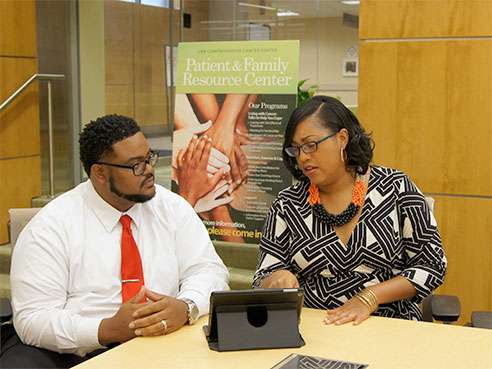Preliminary study shows dramatic trend of cost savings in lay navigation program for cancer patients

UAB presented an observational study at this week's annual American Society of Clinical Oncology meeting in Chicago that indicates a more rapid decline in Medicare costs and patient resource utilization during implementation of a lay navigation program.
In 2012, the UAB Comprehensive Cancer Center created the Patient Care Connect Program, a lay patient navigation initiative with the support of a $15 million Health Care Innovation Challenge Grant Award from the Centers for Medicare and Medicaid Innovation with the aim of achieving better health and better health care at a lower cost.
Based on the premise that coordinated cancer management leads to decreased overall cost, the Patient Care Connect Program is designed to pair a trained nonclinical lay navigator with a cancer patient to help them through their cancer journey.
"The goals of the program are to reduce unnecessary emergency room visits and inpatient intensive care unit days, encourage evidence-based clinical pathways, adopt earlier use of hospice care, reduce use of chemotherapy in the last two weeks of life, and provide the highest quality of life for people diagnosed with cancer," said Edward Partridge, M.D., director of the UAB Comprehensive Cancer Center and principal investigator of the study.
The Patient Care Connect Program has about 40 lay navigators who work across 12 UAB Health System Cancer Community Network associate sites located in Alabama, Florida, Georgia Mississippi and Tennessee.
"Our trained navigators help address the barriers patients often have with identifying resources for their care and empower them to recognize clinical symptoms, become more knowledgeable about their disease and treatment, and when necessary engage in end-of-life discussion with their providers," said Gabrielle Rocque, M.D., assistant professor in the UAB Division of Hematology and Oncology and medical director of the Patient Care Connect Program.
For this study, UAB examined 30,589 Medicare patients (age 65 and older) receiving cancer care across the Network from January 1, 2012, through December 31, 2014. Lay navigation started in March 2013. By the end of 2014 about 25 percent of eligible Medicare patients were navigated.
The study evaluated health care utilization with hospitalizations, ER visits, ICU admissions and hospice admissions for all eligible Medicare patients. In addition, during implementation, the study analyzed the cost to Medicare for the overall medical care received by these patients. The results of the study indicate a dramatic trend toward a clinically significant reduction in health care utilization and Medicare costs, with substantial impact during initial phase, survivorship and the last six months of life. Specific results during the PCCP implementation include:
- Hospitalization rates dropped significantly from 35.8 percent to 16.1 percent in the navigated patient population; in comparison to the non-navigated group that only changed from 10.8 percent to 7.5 percent.
- ER visits decreased from 30.7 percent to 21.8 percent in the navigated patient population; in comparison to the non-navigated group that only changed from 14.6 percent to 13.7 percent.
- With ICU admissions, a dramatic reduction occurred from 10 percent to 4 percent in the navigated patient population; in comparison to the non-navigated group that only changed from 2.5 percent to 1.7 percent.
- In terms of Medicare claims, there was a considerable reduction of overall cost in the navigated patient population from $15,091 to $8,269 per patient per quarter, which is a Medicare savings of $6,822 per navigated patient.
- Cost in the last six months of life decreased from $23,735 to $16,764 per patient for the navigated patient population; in comparison to the non-navigated group that increased from $13,418 to $15,544.
"Certainly this study has its limitations in that some of these trends cannot be fully attributed to the Patient Care Connect Program," Rocque said. "This was a nonrandomized observational study with a lack of comparison data. Lower utilization and Medicare costs may be multifactorial based upon patient navigation, health system improvement, and a number of national and local influences."
However, according to Rocque, "lay navigators have the potential to identify patient needs, communicate with the care team, and contribute to better care and lower health care costs."
With the greatest cost reduction in the last six months of life, Partridge stresses the need for improved end-of-life care.
"Physicians and patients will need to make informed decisions concerning the use of hospice care for advanced illness, and eliminate the use of ineffective chemotherapy treatments in the advanced stages of disease," he said.
As the demand to curb health care cost increases, Partridge said, "there is a need for innovative approaches like this to improve patient care across the cancer continuum."















